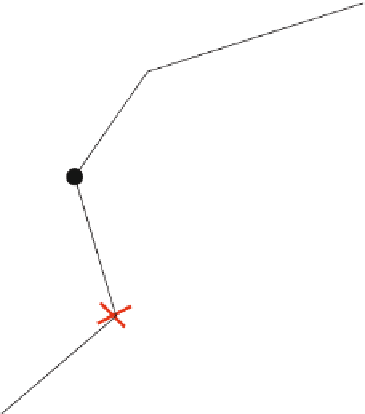Database Reference
In-Depth Information
Time
input
sequence
τ
(x1,y1)
N(x1,y1)
τ
α
1
X
Y
N(x0,y0)
(x0,y0)
α
1
−→
(
x
1
,
y
1
)
Fig. 12.9
Spatiotemporal containment of input sequence on trajectory pattern (
x
0
,
y
0
)
[
14
]
=
···
,
s
n
=
···
,
α
n
where
S
s
0
,
are the elements in the sequence and
A
α
1
,
are
30
min
−−−→
annotated transition time. With TAS, the pattern could be in the format of
X
20
min
−−−→
Y
Z
.
Trajectory pattern [
14
] is defined in the same fashion of TAS where each element
in
S
should be a spatial location:
Definition 12.1 (T-pattern)
A
Trajectory pattern
, called T-pattern, is a pair
(
S
,
A
)
,
where S
=
(
x
0
,
y
0
),
···
,(
x
k
,
y
k
)
is a sequence of points in
R
2
,
and A
=
is the temporal annotation of the sequence.
To judge whether a trajectory
contains
a trajectory pattern, Giannotti et al. [
14
]
propose a definition on spatiotemporal containment. In Fig.
12.9
, input trajectory
sequence
S
1
...S
5
contains trajectory pattern (
x
0
,
y
0
)
α
1
,
···
,
α
k
∈
R
k
+
α
1
−→
(
x
1
,
y
1
), because for each
point (
x
i
,
y
i
) in trajectory pattern, there is a point in trajectory
S
that is close to it. For
example, point
S
3
is close to point (
x
1
,
y
1
) because it is in the spatial neighborhood
(i.e.,
N
(
x
1
,
y
1
)) and also the time difference between (
x
1
,
y
1
) and
S
3
is less than
threshold
τ
. Many approaches can be used as a neighborhood function
N
(
). One
possible neighborhood function is to use the Regions-of-Interest (RoI) to naturally
partition the space into meaning areas. If prior knowledge is not available, RoI can
also be defined as the frequently visited locations/regions mined from the trajectories.
·




































